Alcatel 44004400-PCX

Q-SIG
provides the best modern design for connecting different
PBXs. It is an open, international standard and the world's leading PBX
suppliers supports it.
Q-SIG
protocol is based on ISDN and ensures service compatibility between the public
and
private ISDN. and the private ISDN.
Q-SIG can
work in all kinds of topologies, with no limitation on the number of nodes and
no restrictions on the numbering plan.
The Alcatel
44004400-PCX
offers a
new type of private network interface implementing the Q-SIG--BC
(QSIG Basic Call). Q-SIG BC (ETS 300 172) is the part of the protocol which
describes the basic call and extends the public ISDN access protocol for use in
private Basic Rate Access and Primary Rate Access. As
Alcatel one
of the Q-SIG forum founders, Alcatel supports
this standard, and commits itself to
implementing on a regular basis the evolution
of the norm on a regular basis when standardizedstandardised
by the OSI committee.

The
following numbering plans are supported:
à Heterogeneous numbering plan
à Closed numbering plan
à Open numbering plan (up to 20
digits)
1.Q-SIG - BC services
The level
of services of Q-SIG - BC
(basic
call) is the same as on traditional tie-lines with the main following
advantages:
à number of Ccallering party
and the
connected party number identification
à Voice or data communicationdata calls
For anEa ch outgoing
call on
the Q-SIG trunk generates from Alcatel 4400 on Q-SIG -
BC, a metering ticket is generated on the Q-SIG
trunk of the Alcatel 4400 with the duration of the call.
An In general,
each node in a non-Alcatel network has its own incoming public trunk lines and
attendants, i.e. call distribution is local to the node. Each node also has its
own public outgoing trunk lines.
Nevertheless,
using the proprietary features of the Alcatel 4400, and depending on the
capabilities of third party PBX, enhancement of services is possible.
Alcatel 44004400-PCX
subscriber can make a public call vthat will take ia a
public trunk line located onin another PBX
through the QSIG-BC interface. In that case, external call barring is performed
in the Alcatel 44004400-PCX. In addition, for all incoming Q-SIG -BC i
For an
incomingncoming call, if the Party Category is sent
by the connected PBX, in the
Alcatel 4400 from the Q-SIG -BC interface, if the Party
Category is received the Alcatel 44004400-PCX
is able to differentiate calls originating from private subscribers
and public trunks, and s:react as
followsing:
à callsCalls
originating ed from private
networks
are treated as internal calls ion waiting queues
on attendants.
à storageStorage
of public
calls public originated
calls in the non answerednon-answered call
repertory.
à forFor
calls coming from the public network through Q-SIG - BC,
overflow on no answer or busy subscriber can be
processed either in the Alcatel 44004400-PCX or in the
transit network, depending on the management.
GF
(General Feature) and SS (ssupplementary
services) are the services
The enhancements of the BC ‘ Basic Call’ has been called GF of QSIG-BC. ‘ General
Feature’ and the SS ‘supplementary services’ . This additional
module allows to increase the service level in heterogeneous environment . Additional
services have been defined as part of the new standard. Those standards, as soon quick as
they are
availableappear, are implemented on a regular
basis in the Alcatel 44004400-PCX
proprietary network protocol.
The other
QSIG-GF benefit in addition to the standardization is the
transparency. The private network protocol ABC-F is based on QISG-BC and
QSIG-GF, then for 4400s in relation through a QSIG-BC-CF based network, the
telephone service available is ABC-F.
The QSIG-GF
provides name identification plus
feature
transparency mechanism. QSIG-SS, provides telephone services such as:
SS interface although less
attractive than a ABC-F interface provides the following services in network :
à Calling Line Identification
Presentation
à Connected Line Identification
Presentation
à Calling/Connected Line
Identification Restriction
à Calling Name Identification
Presentation
à Connected Name Identification
Presentation
à Calling/Connected Name
Identification Restriction
à Generic Functional Procedures
à Call Forwarding - Unconditional
à Call Forwarding - Busy
à Call Forwarding on No Reply
à Call Transfer
à Path Replacement
à Call Completion to Busy Subscriber
à Call Completion on No Reply
à Call Offer
à Advice oOf
Charge
D.4400 homogeneous network
services
The Alcatel 44004400-PCX systems can be easily networked,
to reach very high capacitiesy of , up
to 50 000 extensions, in various geographic topologiesy of 100 nodes.
The services between the Alcatel 44004400-PCXs
use a powerful proprietary protocol : The Alcatel Business
Communication or ABC
protocol. This architecture of this protocol is based on five modules :
à
ABC-F homogeneous: supporting the telephone features
à
ABC-F heterogeneous Alcatel: supporting a sub-set of telephone features
à
ABC-M: supporting the management mechanisms
à
ABC-R: supporting the routing algorithms
à
ABC-A: supporting the network applications
In addition, this architecture is based on the
standard protocol QSIG-BC, and GF. This has the for advantage
tof
facilitateing the integration
of the 44004400-PCX integration
in heterogeneous environments,
and to
providing e an ABC-F
service level between 44004400-PCX saan ABC-F
service level.


The network
can be configured in various topologies : Line,
Star, full meshed, or a mixture of them..
The connections are made via Digital leased lines E1, fractional E1, Frame relay
X24/V11, ATM 155 MBPS, IP 10 BT, and analogue BRA, BPRA or tie-linestie-lines
interfaces.


The number of
nodes supported is 100, the "homogeneous
configuration" can reach 32 nodes,
and the remaining nodes are satellites of these main
nodes. Whatever the topology,ies the service
level is the same throughout the network. Many homogeneous
44004400-PCX
private
networks or sub-networks can be federated in an
extended configuration called "Corporatecorporate
network".
Each sub-network, retains its own external connections,
attendants, centralizedcentralised
applications, and management, but ABC-F and
ARS/LCR telephone services ABC-F and ARS/LCR remain
coherent throughout the whole corporate network. The
advantage of t. And they form a
consistent whole as regards telephone services for users and cost optimization
arrangements.
This
configuration is that ahas for advantages to
federate a large company spread over national or international
territories can be federated through an efficient
voice communication network, whilst maintaining local reactivity.

This is a
4400 remote shelf connected to the main Crystal. The remote Crystal is the
solution for a distributed architecture on a large campus, to profit from
existing structured cabling and to use on the primary fibre optic
cabling fibre optic. It is also a cost
optimised solution for company branches, which with needs
of the utmost
homogeneity. And fFinally, this remote
shelf could be a controller for DECT radio base stations in order to cover a large area. The connectivity is as the followings:
à Remote Crystal based on fibberre optic (INTOF
board):
§ Multi-mode or mono-mode fibre optic
§ 4x8 Mbits connection between
remote shelf and main crystal
à Remote Crystal based on copper
cabling (INTOF board):
§ DECT hand-over and roaming
between crystals
§ 4x8 Mbit/s connection between
remote shelf and main crystal
à Remote Crystal over public
leased line (RT2 board)
§ E1 or fractional E1 connection
between remote shelf and main crystal
It is possible to connect branch
offices with a high security level to the corporate
network with a remote Crystal shelfve
Crystal
via a 64 KBPS leased line. Thanks to the integrated
compression engine integrated in the LIO B board, LIO B the leased
line supports up to 6 voice
communications, and in case of link failure,
communications are backed up over
ISDN,
with up to 6 communications in one B channel whilst retaining the
same level of telephone services.
TraditionalThe
classical network solutions are based on digital leased lines, typically E1
or fractional E1. However,But as a result of the
evolution of technology evolution, we
now have real opportunities to build up flexible and cost effective innovative
networking solutions.
The
traditional transport of voice over digital circuits useds to require
64Kbs per second. Thatese istimes are
now over thanks to the new Alcatel 4400-PCX advanced
compression engine, which allows up to 6 simultaneous
communications into the traditional 64 KBPS channel. In
configurations based on digital leased lines, the quality is
constant, voice is compressed/decompressed once (end to end) whatever the topologies (transit nodes). In
configurations based on digital and analogue leased lines, only two
compression/decompression operations are
authorised, and controlled by the
network protocol in order to guarantee voice
quality. The
characteristics asre the followings:
à 8 compression modules are
integrated in the following boards:
§ LIO P2, (PRA
access)
§ LIO B2, (4 BRA
access, plus one X24/V11or V36 access)
§ LIO X2, (auxiliary)
à Compression algorithms: G723.1, G 729A
à Compression rate: 6.4 KBPS, 8 KBPS
à
Allocation of
the compression algorithm:
§
Static
§
Per bundles
between A 4400-PCX
à Integrated echo cancellation
à Fax G3 up to 9600 BPS
à MF Q23 codes interpreted, coded
and regenerated
à Lost frames interpolation
à Silence suppression and
regeneration
à End to end
compression/decompression
à Voice frame fragmentation
(reducing delay)
à Mutual help between compression
resources
The
implementation of Voice over IP services on the Alcatel 4400 provides a new
cost/quality ratio together with a high level of voice
services. level.
Voice over IP implementation provides the full ABC
networking feature transparency thanks to the multiplexing of voice and
signalling on OmniPCX 4400 links. Integrated voice over IP provides the
following services:
à LIO E Board e LIO E insuring
voice compression and IP packets IP encapsulation
à
Ethernet
10 BT
à
30
compressed voice channels per board (base 12)
à
50
boards maximum per system
à
Packet
algorithm: G 711
à Compression algorithms: G723.1, G 729A
à
Compression
rate: 6.4 KBPS, 8 KBPS
à
Allocation of
the compression algorithm:
§
Per bundles
between OmniPCX 4400
§
Call by call
with H 323 device
à MF Q23 codes coded and
regenerated
à
Silence
suppression and regeneration
à Lost frame interpolation
à Echo cancellation
à Fax modulation/demodulation at
9.6 KBPS (fax relay T 38)
à Automatic fax detection
à Dynamic jitters buffer per
direction
à Inter node transit
à Multiple VoIP bundles
The
voice over IP service is compliant with the video
conferencing over H 323 packet network H 323. The Iintegrated
VoIP is a "VoIP gateway" in the H
323 terminology, and can inter- operate
with other equipment as far the
standard implementation is similar. The cCompliance
with the H 323 standard
enables communication between
telephone sets and PCs with having audio
capabilityies and a H 323 client H 323 such
as Microsoft NetMeeting, or Netscape
communicator (conference). When a telephone user calls a PC by
dialling its directory number, the Alcatel
4400-PCX translates the PC telephone
number (E 164) into its IP address. If a gatekeeper already exists
in the network, the Alcatel OmniPCX 4400 can become a gatekeeper
client (Client RAS protocol) and, for each
call, can then request
the PC’s IP address fromto the gatekeeper for each
call the PC IP address. For calls
from a PC to a telephone set or a trunk, the PC has only
has to send the LIO E IP address
followed by the telephone directory number. The
telephone service level between the PC and
PC/telephone set is limited to
basic calls due to the currentH 323
limitations of the H 323 standard
limitations.
The Alcatel 4400-PCX natively integrates
mechanisms to helping non- deterministic
IP networks to provide
"Voice grade" quality:
à Tagging voice
packets according to 802.1p and TOS standards 802.1p and
TOS enabling switches and routers to identify
voice packets
à IP traffic limitation
à Communication overflow to
another communication network in case of IP network saturation
It is possible to define the number of
voice channels supported by an "IP TRUNK".,
wWhen the IP-TRUNK
is totally busy, the communications can overflow
via another network according to user rights.
In an
IP-TRUNK, Iit is possible
to define in an IP-TRUNK, the number of
communications possible according to a direction,
in fact to define a virtual "IP-bundle". When the
IP-bundle is totally busy, the communications
can overflow via another network according to user rights.
The Alcatel
4400-PCX LIO E board provides an "IP
quality monitoring" service; allowing, when quality
goes beyond a given threshold,, calls can
be automatically calls re-routinged toward public
ISDN for example. On IP it is possible to continually
monitor permanently performance
parameters such as packets loss rate, jitter and delay thanks to the RTCP protocol RTCP.
According to a given direction, when the quality
reaches a threshold
composed of a mix of delay, packet loss and
jitter, new calls are routed toward a public ISDN or digital R2
network with in direct or
indirect access according to user rights. When the quality
increases again, new calls are
routed via Tthe IP
network. Several IP quality levels can be
defined,
corresponding to several classes of calling
users. For Eexample, a user with
"Higher VoIP privilege", will be routed on IP only if the
quality is compliant with the indicator "Very good quality", if the otherwise in
case of indicator is "medium
quality", these users will be automatically routed
toward ISDN. . When the IP network is out of service, new calls
are routed toward ISDN without ABC services.
As the VoIP trunk group,
is defined in the same way as traditional
voice circuit trunk groups, the same
comprehensive traffic observation services are available. Please
refer to the management description for more details.
As Frame
Relay technology becomes more and more mature and able to
support voice traffic in good conditions, it is particularly useful to
interconnect sites with lowsmall
to medium traffic. The Alcatel 4400 provides NATIVE Frame Relay networking service,
allowing connection to either
private or public Frame Relay switches. The service characteristics are as the followings:
à LIO B 2 Board LIO B 2 einsuring
voice compression and packet encapsulation
à Interface X24/V11
or V36 Interface
à Interface speed 64, 128 KBPS
à 8 integrated compression
resources per board
à 12 voice channels per board
à Two directions per board
with digital leased line
à Four PVCs per board
when connected to private or public FR
à 6 voice channelsl
max per PVC
à Compression algorithm: G723.1, G 729A
à Compression rate: 6,4 KBPS, 8 KBPS
à Integrated echo cancellation
à Fax G3 up to 9600 BPS
à MF Q23 codes interpreted, coded
and regenerated
à Lost frames interpolation
à Silence suppression and
regeneration
à End to end compression/decompression
à Data frame fragmentation
(reducing delay)
à Mutual help between compression
resources
It is
possible to define the number of voice channels supported by PVC. wWhen it is
totally busy, the
communications can overflow via another network according to user rights.
When the PVC is totally
busy, following communications can overflow according to user rights ontotoward
a private or public ISDN or digital R2 network within direct or indirect access.
As the VoFR
trunk group, is defined in the same way as
traditional voice circuit trunk groups, the same
comprehensive traffic observation services are available. Please refer to the
management description for more details.
Today many
campus communication infrastructures are migrateing toward ATM technology. It is the
right way to integrate legacy data traffic with other company information flows
when real time is critical. Alcatel 4400 supports native ATM connectivity
providing a seamless integration of voice and ABC services over ATM networks. The service
characteristics are as followsthe following:
à ATM Interface 155 Mbits/s
(STM1/OC3)
à Multiplexing of E1 trunks in
ATM cells
à 4 ATM boards per 4400
à 8 E1 trunks (240 channels) per
board
à Compliant with integrated
compression auxiliary (LIO-X)
à Segmentation and Re-assembly
(SAR)
à ATM adaptation Layer 1 (AAL 1)
à Unstructured mode (CES 1.0)
using Permanent Virtual Circuits (PVC’s)
à Supporrts of
8 directions (PVC’s) per interface
Networking
small sites with low or medium voice traffic does not always justify dedicated
leased lines. As a result of infrastructure evolution,
carriers can offer an increasing number of switched connections combined with attractive
tariffs. In line with this ongoing evolution, the Alcatel 4400-PCX supports
versatile virtual networking solutions offering real
advantages.
CThe cost
considerations for the private network architecture usually lead tomost often
implies links bandwidth limitation. However,At the
opposite, to provide a good quality of service, the private
links have to be dimensioned more or less according to the maximum traffic
peak. This results in has for result unused bandwidth
being unused for during long time periods of time,
and costly subscription. The best way to optimise bandwidth, is firstly, the
reduction of leased line size according to the traffictraffic and,
secondly, traffic peak overflow through an alternative network: ISDN,
Q-SIG, analogue DID, or E1 R2.

Alcatel VPN
configuration offers full ABC services (ABC-F-M-R-A) whatever the network
is used to transport voice, the telephone
signalling having always has a reserved
channel in the leased line (D channel). AlsoAlways
to optimise costs, we use Virtual DDI to
overflow the communications when the
leased line is saturated. A limited set of DDI numbers is reserved for this
service (according to the traffic), so then that we can
integrate subscribers with or without DDI into the network, whilst saving DDI subscription
costs
subscription. The network manager can manage precisely
the overflow precisely, the service
can be allocated user by per user and then the
cost then remains under control with an
good accurate quality
of service. When the leased link is saturated, a friendly voice guide suggests an
«automatic call back request» proposes to a user who is not not so entitled
to an overflow an «automatic call back
request» operation. In addition, in the 4400-PCX metering
application, a flag is associated to each
overflowed communication. This means that the Thanks to
that, the network manager has a precise and
factual indicator to analyse whether the service remains
consistent over a period of time period., if the
service remains consistent.
This service can be combined
with the Alcatel 4400-PCX advanced
compression engine, which allows up to 8 simultaneous communications into
64 KBPS channel or 5 simultaneous communications in
56 KBPS either
on the digital leased line or public ISDN, giving leading to an unrivalled cost-effective application.
For some configurations with low
traffic levels a dedicated E1 link
cannot be justified. For such topology, the A4400-PCX
provides the solution to interconnect systems with full ABC services. We use
the available public ISDN or
QSIG network ISDN or QSIG available to
transport voice, and another network to transport
signalling as:
à TCP-IP network
à Synchronous V24 modem (Analogue
ABC)
à X25 Packet X25 in
D channels (LLP) when available.

Alcatel VPN
configuration offers full ABC services (ABC-F-M-R-A), with the telephone
signalling always having always a
reserved channel in the leased line (D channel). Alsoways to optimise costs, we use
Virtual DDI for the
communications between sites. A limited set of DDI numbers
is reserved for this service (according to the traffic), sothen
we can integrate subscribers with or without DDI into the network, whilst
saving DDI cost subscription costs. In
addition, in the 4400-PCX metering application a flag is associated to each
overflowed communication. This means that the network
manager has a precise and factual indicator to analyse whether the service
remains consistent over a period of time.
Thanks to
that, the network manager has precise and factual indicator to analyse over a
time period, if the service remains consistent.
This service
can be combined with the OmniPCX 4400 advanced compression engine, which allows
up to 6 simultaneous communications in 64 KBPS channel or 5 simultaneous
communications in 56 KBPS either on the digital leased line or public ISDN,
giving an unrivalled cost-effective application.
This solution
makes it possible to build up a powerful
private voice network over ISDN, or Q-SIG public
switched network without a permanent connection. This application combines
integrated voice compression engine and signalling on demand services. When it is
required, one B channel is set up between two nodes, this “virtual leased line”
transports the both networks signalling
and compressed voice of both networks. Up to 8 communications in the
same B channel. The “Virtual leased line” is released when there is no more
private traffic. This solution targets networks located in the same cost area,
and combines great flexibility and tremendous cost savings.

To improve total cost of
ownership, bandwidth demanding management operations bandwidth
demanding such metering files, user
modification, etc can be activated only when a voice
communication occurs. It is also possible between two sites
to dynamically activate dynamically one B channel
per direction between two sites, in order to clearly
differentiate and allocate the communication costs.
It is
possible to set-up an efficient private ABC networks providing the
complete set of services (ABC-F-R-M-A) via analogue tie lines. For that an
analogue leased line is dedicated to support the telephone
signalling, via a couple of synchronous or
asynchronous modems (from 9600b/s up to 34800b/s), the voice is
supported by standard tie-lines. With an analogue ABC
network we have the same benefits as with digital
lines, we can overflow communications through the public ISDN network when the
links are busy, or out of service. To provide this service a built-in
application continuallycheck checkspermanently
the availability of free tie lines by an exchange of DTMF frequencies between sites inter
connected sites.

A single
operator group or several operator groups can handle all the calls
of the whole network in a distributed or centralised configuration.
The assigned
night service stations can be in different nodes from the one of the operator.
If there are several assigned night service stations, they can be in different
nodes.
The closed
numbering
plan can reach eight digits it can be sliced or mixed and customised to all
configurations.
It is
possible to move a subscriber toin
another network node without changing the extension number.
In a network, the Alcatel 44004400-PCX
offers the following features:
à Basic call
à Number and name identification display of
name
à Ccall
by name
à Call waiting indication
à Call offer
à Call back on busy links
à Call back on free or busy extensions
à Call park
à Call deflection
à Camp on
à Individual call pick-up
à Data communication
à Distinctive ringing
based on hierarchies
à Hold
à Intercom call
à or by numberEInquiry
call
à Bbroker
call
à Ttransfer
à Cconference
à Iintrusion
à
automatic callback to busy
station
à
waiting
off-hook
à Uunconditional
forwarding
à Conditional
forwarding(forwarding on no reply, forwarding on busy, immediate forwarding or
forwarding on no reply and busy)
à Ssubstitution
(forwarding
on no reply, forwarding on busy, immediate forwarding or forwarding on no reply
and busy)
à Ddon't
disturb
à DISA
à Text mini-messaging
à Rreading
of personal charging pulse meters
à Ttransparency
in decade and Q 23 dialingdialling
à Rretransmission
of last number dialeddialled
à ISDN supplementary services
à
associate in
network
à Entity routing for muti
company/departement configuration
à Three party conference
à 29 party conference
à Associate in network
à Immediate forwarding to
associate
à Conditional forwarding to
associate
à Manager/Secretary filtering
team
à Object supervision: free,
partially busy, totally busy, ringing)
à Hunting group of
subscriber
Automatic callback on busy
ABC-F links
In a
network, the Alcatel 44004400-PCX
offers the following features:
à Basic call
à Number and name identification
à Class of service identification
à Dynamic access
to user communication resources (DECT, Voice mail,
text mail etc)
à Multi-tenant servicedisplay of
name
à Ccall
by name
à Call offer or by number
à EIinquiry
call
à Chained call
à Bbroker
call
à Ttransfer with or
without presentation
à Three party conference
à Twenty nine party conferenceconference
à Intrusion
à Text advertising message on busy user display
à Text mini-messaginge
à Rreading
of personal charging pulse meters
à Ttransparency
in decade and Q 23 dialingdialling
à Rretransmission
of last number dialeddialled
à Sstation
reservation
à Trunk reservation
à Bundle reservation
à
supervision of
device status
à Hputting on hold
à Ooverflow ing of
unanswered external calls
à Do not disturb override
à Trunk allotting with or without
barring
à Entity or installation status
management (day, night, fwdrenv1,
renvfwd2)
à Large busy lamp field
supervision
à User, abbreviated numbers and
entities management
b.Centralized, distributed
or shared voice mail
The voice
mail architectureapplication
can adopt different configurations. The service can be centralizedcentralised
for the whole network, one voice mail can be shared byetweenby
severalfew nodes and another one by
the remaining nodes, or each node can retain its own voice mail system.


Whatever
the configuration, for the user and network manager the
service is the same as equivalent to a singleunique
voice mail system.
5.ABC R: Routing
The Alcatel
44004400-PCX
ABC network is condensed by an efficient routing mechanism called adaptive
routing. Each node is permanently informed of the link availability and traffic
load. Thus, an Alcatel 44004400-PCX will choose immediately
choose
the best available route to reach the requested device wand will hilst permanently
adjusting
and balancinge the links’
traffic load. This powerful routing algorithm called
"Adaptive Routing" can be
composed as an O.S.P.F equivalent O.S.P.Ff data
protocol
equivalent for example, and provides
a high security level and real link optimizationoptimisation. The services
supported are the following:
à Adaptive routing
à Link traffic balance
à Flexible network numbering plan
à Multiple public
translators
à Multi-tenant ARS
à Multiple DDI translators
à Multiple call barring
translators
à Forced on-net
à Break-in
à Break-out
à Private to public overflow
(according to user rights)
6.Alternate route selection/Least cost
routing
Least cost
routing application embedded into the Alternate route selection (module ABC-R) can be
centralised or distributed on each network node. This application has
the for goal
tof
optimizeoptimising e communication
costs
through
by the time- based
choice of the best-priced carrier. This service is or to
maintain the service level in private homogeneous network. This service is totally
transparent for the network users.
The services offered are the following :following:
à 20 000 routes
à 1000 routes lists
à 1 to 30 digit number analysed digit number
à Number translation (add or
delete)
à Direct or indirect
Multi-carrier access
à 5 different carriers overflow
à Overflow to other carriers
according to user rights
à Cost limit perper
user/Installation status
à Information voice prompt in case of
overflow toward an expensive route
à Information voice prompt if n case of cheapest
route is nunon available
à Automatic call back on busy
cheapest route
à ARS time dependant:
§ Day of week: 100 weekly
tables
§ Hour and minute of the day: 5 daily tables per weekly table table
Out of Through habit,
or
because the user has not reprogrammed the terminal or because of
the proliferation of personal directories on the PC, company
employees , often call
private network users via the carrier's DDI service call often private
network users are called via the carrier's DDI service when a
private network is available, which is not the best way of minimizingminimising
communicationcall
costs.
In our example, an employee calls an on-net
number via an external network, and for this possible internal call, the company will pay for an
external communication and will lose money.
Now. The with ARS/LCR
application built into the OmniPCX 4400, continually
analysesise permanently the
number dialled before setting up the call. , the address
information (the number dialed) is analyzed. If
the called partynumber belongs to thea
private network subscriber, the ARS application will
automatically
choose automatically the
cheapest route, -, in
this case a private route, -, for the
call without losing the benefits of the "Aadaptive
Rrouting" service..


In a private network based on
leased lines, one One network subscriber
on a
site wants to contact a correspondent located in another city.
Before the
call is set up, the naddress
information umber dialled is analyzedanalysed
by ARS/LCR. Each 4400OmniPCX 4400 knows the
exact topology of the private network at all times and has real time knowledge
of the availability of the different routes and their traffic loading
(information via the D-channel signalingsignalling D-channel).
So the 4400OmniPCX
4400 can select the cheapest route over both public and private infrastructures
and make an external call into the closer addressee network
site.
We have a
private network based on leased lines a remote site in another city through a
VPN configuration. Through habit, or because the user has not reprogrammed the
terminal or because of the proliferation of personal directories on PC, private
network users are called via the carrier's DDI service when a private network
is available, which is not the best way of minimizing call costs.
In this
example, a corporate
subscriber wants to contact a branch
subscriber, andA subscriber on remote site wants to
contact another network subscriber dialscomposes the public
DDI number. The Before the call is set up, the address
informatiodialled number is n is analyzedanalysed
by the
ARS/LCR application. So ,
and as the addressee belongs to the corporate network (Branch
in VPN configuration), the 4400OmniPCX
4400 can
selectselects the cheapest route cover both ombining public
and private communication infrastructuresinfrastructures. . In our
example, subscribers are far apart and there is no direct private route for the
call. From the internal routing, the network will also set-up A private
network route and a one public
one one local
external are automatically selected, call to providinge
athe
communication
at local cost, connection rather than a direct long
distance call.


In this example, we have two private networks. Tin different
countries. These two networks retaining their own
dynamic and independence in terms of configuration and resource sharing. However, they form a consistent
whole as regards telephone services for users and cost optimizationoptimisation
arrangements.
A network user wants to talk tocontact someone abroad. On each call,
address information is analyzedanalysed by the
ARS application. Abuilt into
each 4400. According to the
call direction,
and direction and transparently
to the user, the best least cost -priced carrier
will be selected irrespective of the physical connection in the network. The
address information is modified to suit the carrier numbering scheme (by
adding, removing or converting digits) and the called number and converted
number are stored in charging tickets.
When the cheapest least cost carrier
for this call is not available (congested), the caller, if so entitled, is
diverted to another carrier offering a higher tariff. The user is informed of routethe
change of
route by
a
a friendly
voice message. He cancans
hang-up and trytryies
again later if the call is not urgent, or waitwaits
for the call to overflow. At the end of the waiting message, the call is
diverted to the second carrier, the number being automatically adapted as in
the previous case. The ARS application allows to selectselecting
successively five different carriers to be . selected
successively.
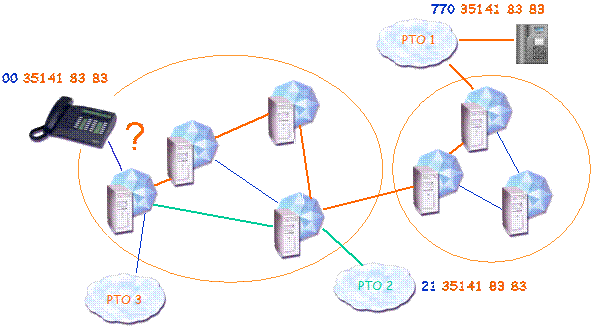
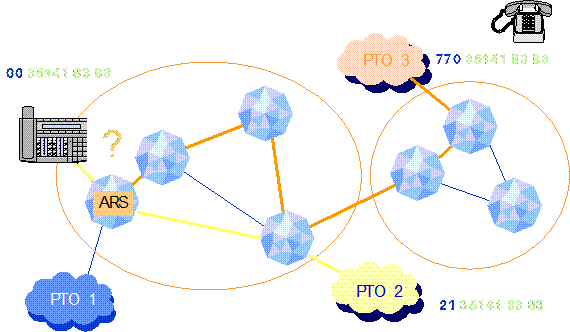


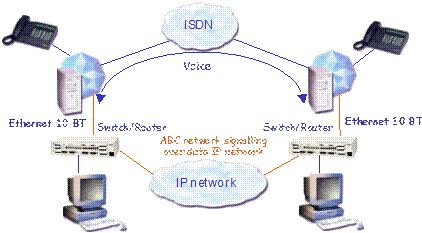 |
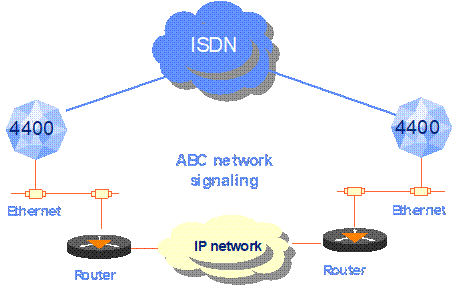
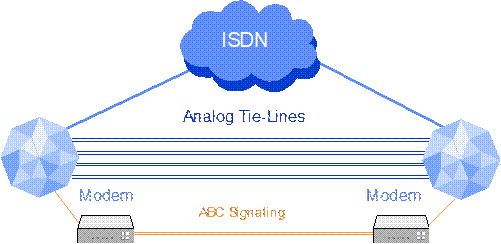
This solution provides a subset of ABC private
network by using only the ISDN network, no leased line is required neither for
voice nor for telephone signaling. The voice is transported over
standard public ISDN network, the signaling transport is
based on the USS1 service provides by ISDN Public Network.
à
This
solution enables you to benefit of services like:
à
Distribution
of incoming public calls based on virtual DID
à
Homogeneous
private numbering plan
à
ISVPN
call is seen as an internal call, not a public one
à
Name
identification (with transport of number)
à
Optimized transfer
(loop avoidance & optimized call
forwarding)
à
Call
back request (on 40011,up to 4040 Reflex sets)
à
Intrusion
à
Other
4400 features over ISDN without
ISVPN added value
à
Call
distribution in network: centralized attendants
à
Inter-working
with ABC networks
à
Centralized management
The Alcatel 4400 offers a
compliant legacy DPNSS interface and protocol, mainly used to connect the voice
communication system to:
à
Installed base DPNSS not
compatible with QSIG
à
VPN offer of BT ( FEATURENET)
and Mercury in UK
à
Alternative
carriers, e.g. GSM operators in Germany and Sweden...
à
Legacy applications
The
DPNSS services supported are :
à
Voice
and data call ( 6 and 7)
à
Call
back when free ( call completion on busy set) (9)
à
Intrusion
(10)
à
Call
forwarding (11)
à
Hold
(12)
à
Inquiry
call (13)
à
Transfer
(13)
à
Conference
(13)
à
Call
offer (14)
à
Service
independent string (16) Name
à
Call
waiting (17)
à
Route optimization (19)
à
Centralized night
service (25)
à
Do
not disturb (32)
à
Loop
avoidance ( 37)
The management tools are based on powerful
stations running on W95 or UNIX. They provide a complete set of Alcatel
graphical applications designed to facilitate day-to-day management operations.
The management stations are connected through a native
10BT Ethernet
10BT link,
to one
of a network node, and adopt the client client/server
architecture and the object model. DThe dialogue
between the management station and the 4400OmniPCX
4400 is based on standard protocols: FTP, CMIP/CMISE. We use CMIP/CMISE, rather
than SNMP as it is because it’s more
powerful, and has the ability to manage a
complete set of instances (create, suppressdelete, etc.).
Therefore we integrate SNMP protocol in order to federate the
network supervision with other company management tools.
The mThe management
can be centralizedcentralised,
distributed or both;, many management
stations can operate simultaneously without problems withof
data
basesdatabase constancy.
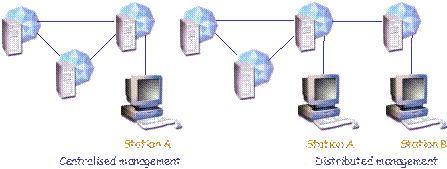
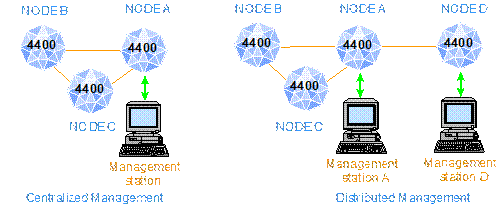
The management station manages
one,
several or all the nodes inside ana
homogeneous OmniPCX 4400 network. This facility is given
without using any bandwidth on the B channels of the ABC links, but by using
the Data part of the signalingsignalling channel
(D channel) and a powerful mechanism called: Broadcast.
From now on, with the 4400OmniPCX
4400 the network manager can program or modify -from ONE window- any
system, subscriber, or voice mails parameters from ONE
window. Automatically Tthe
other network nodes and also the centralizedcentralised
directory are immediately informed automatically and their data basedatabase
updated with consistent information.
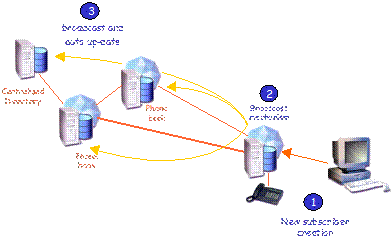
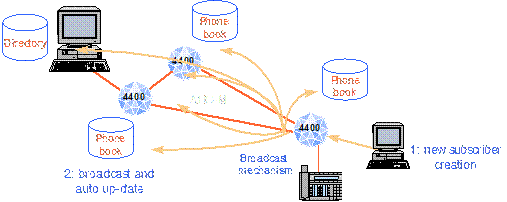
Another service is supported by ABC-R is the Audit
service. This mechanism has been design to facilitate network reconfiguration
or evolution, and also to easily integrate
easily
a voice mail in a second step. After a local configuration, thanks
to the
Audit command, a new node learn automatically
learns
the network configuration and updates its database
(network translator, pPhone book,
etc.), the voice mail updates the subscriber’s database.
When an user is
created in a node, the network manager attributes voice mail
services (mail box and user profile) directly from the user
management window (no need offor two
management operations). Automatically Tthe
voice mail will automatically create a virtual "« user
mail box" »
in the other network voice mails.
Then
eEach user can then create
distribution lists, transfer messages etc. to the other
users in a network as if they wereare in the same node.
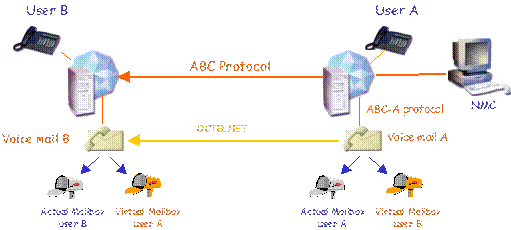
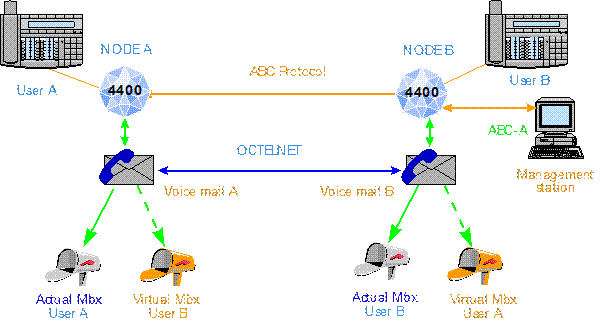
This solution provides a subset
of an ABC private network by using
only the ISDN network, no leased line is required neither for
voice nor
for telephone signalling. The voice is transported over the standard
public ISDN network, the signalling transport is based on the USS1 service
provideds by the ISDN Public
Network.
This solution enables to benefit of from services
like:
à Distribution of incoming public
calls based on virtual DID
à Homogeneous private numbering
plan
à ISVPN call is seen as an
internal call, not a public one
à Name identification (with
transport of number)
à Optimised transfer (loop
avoidance & optimised call
forwarding)
à Call back request (on 40011 ,up
to 4040 Reflex sets)
à Intrusion
à Other 4400-PCX features over
ISDN without ISVPN added value
à Call distribution in network:
centralised attendants
à Inter-working with ABC networks
à Centralised management
The Alcatel 4400-PCX offers a compliant legacy
DPNSS interface and protocol, mainly used to connect the voice communication
system to:
à DPNSS iInstalled
base DPNSS
not compatible with QSIG
à VPN offer of BT ( FEATURENET)
and Mercury in UK
à Alternative carriers, e.g. GSM
operators in Germany and Sweden...
à Legacy applications
The DPNSS services supported
are:
à Voice and data call ( 6 and 7)
à Call back when free ( call
completion on busy set) (9)
à Intrusion (10)
à Call forwarding (11)
à Hold (12)
à EInquiry
call (13)
à Transfer (13)
à Conference (13)
à Call offer (14)
à Service independent string (16) Name
à Call waiting (17)
à Route optimisation (19)
à Centralised night service (25)
à Do not disturb (32)
à Loop avoidance ( 37)
Master/slave
(country dependent)
The master / slave
configuration offers multimMulti- site
companies common and centralizedcentralised resources
and telephony
features on an analoganalogue
network. The centralizedcentralised
services are as the followings:
à external bundle and DID
à attendants
à closed numbering plan
à display/name
à call by name/number
à ienquiry
call
à broker call
à transfer
à conference
à substitution
à DISA
à unconditional forwarding
One master hasserves
one or several slaves.
Each slave
is linked to the master by an automatic tie line analogue trunk
with two or four wires (a, b, E&M).
DialingDialling
can be transmitted in DTMF Q 23.
In addition
to the features offered locally by each PBX to its own users, the Alcatel 4400OmniPCX
4400 master function offers:
à Handling of outgoing and
incoming calls on the bundles of the master with the same possibilities for the
stations of the slave or slaves as for the stations of the master.
à Handling of local waiting queue
for master and slave stations.
Re-transmitting the pulses received for
outgoing calls from the master bundle towards the slave metering system.
Each slave is linked to the master by an automatic
tie line analogue trunk (a, b, E&M).
DialingDialling
can be transmitted in Q 23 frequencies and , .
eEach
slave can have its own external bundles and operators.